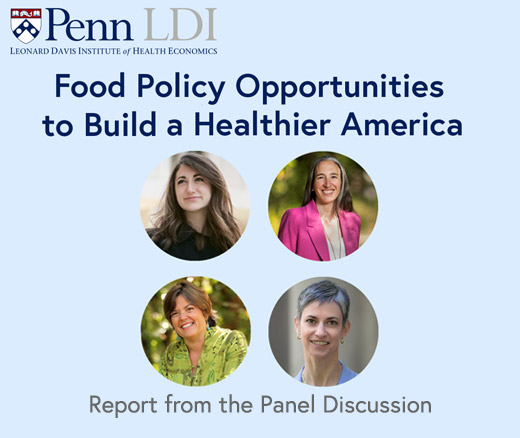
Contradictions That Confuse Federal Food Policies
Announcing Bold New Goals While Crippling the Infrastructure Needed to Achieve Them
Population Health
Blog Post

As a neonatologist caring for babies, I have the great privilege of attending many births, bearing witness to the moment when a new life enters the world. While each birth story is unique, there are recurring pieces that I treasure, such as the wail of a newborn, the smile on a mother’s face as she holds her infant for the first time, and the tradition of cutting the umbilical cord. Each birth fills me with joy and profound hope for the future.
However, far too many American families have that hope and joy completely shattered. Each year, over 20,500 infants die before reaching their first birthday. Deaths occur due to many causes—from birth defects, complications from being born too early, infections, injuries, or sudden unexpected infant death (SUID), which includes sudden infant death syndrome (SIDS). The infant mortality rate in the U.S. is almost twice as high as other developed countries. In some states, the rates are on par with nations like Turkey or Costa Rica, representing a significant variation of infant mortality rates across communities.
Through my time treating newborns, I have learned one essential lesson: The connection between mothers and infants is not severed when the umbilical cord is cut. Their health outcomes remain intertwined, not only with each other, but with the community around them. Infant mortality has long been linked to mothers who have high blood pressure, diabetes, obesity, poor mental health, and the parent’s feeding or sleeping practices. Yet, this focus on an individual mother’s health and behaviors fails to account for community conditions that affect the health of mothers and obscures the responsibilities that we have as a society to support mothers and infants.
In a study published in the Journal of Pediatrics, my coauthors and I sought to look beyond a mother’s medical and social risk factors that increase her infant’s risk of dying. We analyzed community-level factors that make mothers vulnerable to poor health and determined the impact of these factors on infant mortality.
As the first study to conduct a national evaluation of multiple community risk factors and infant mortality, we used the Maternal Vulnerability Index (MVI). This new measure from the nonprofit Surgo Ventures seeks to explain county-level differences in factors that relate to death and disease among mothers. Counties with the highest MVI scores, indicating the most vulnerability for mothers, have greater rates of maternal deaths, maternal morbidity, and premature births.
In our study, we matched county vulnerability scores to birth and death records for over 11 million babies. We found that the frequency of infant death was 1.9 times greater in counties with the highest MVI scores compared to counties with the lowest score. For every 20-point jump in the vulnerability score, the risk of infant death rose 6%. This relationship held true for six of the seven most common causes of mortality.
In addition, Surgo Ventures also presents a “theme signature,” calculating vulnerability scores across six specific areas with a distinct relationship to maternal health. While five themes were related to infant death, we found that county-level vulnerabilities related to mental health and substance use had a particularly strong relationship to infant death.
Our work suggests there are potential contributors for the state-by-state variation seen in infant mortality rates. Communities that failed to support mothers were the same ones with higher rates of infant death–regardless of the cause of death.
While sobering, these findings point to solutions: Programs that improve maternal health may reduce infant death as well. The MVI “theme signature” gives a comprehensive view of the unique stressors in a community and may help to design and evaluate interventions that best fit local needs.
Most importantly, our work reaffirms that improving infant health requires us to prioritize maternal health by building healthier communities. Researchers, pediatric providers, insurers, and policymakers can each play a role:
Each day at work, I am reminded about the precious link between mothers and their children and what happens if we, as a society, fail to invest in nurturing this connection. Our work points to the need to design and test strategies focused on supporting mothers to reduce infant deaths.
The study, “County-Level Structural Vulnerabilities in Maternal Health and Geographic Variation in Infant Mortality,” was published on August 29, 2024, in The Journal of Pediatrics. Authors include Daria C. Murosko, Josh Radack, Alejandra Barreto, Molly Passarella, Brielle Formanowski, Carolyn McGann, Timothy Nelin, Kathryn Paul, Michelle-Marie Peña, Elizabeth G. Salazar, Heather H. Burris, Sara C. Handley, Diana Montoya-Williams, and Scott A. Lorch.


Announcing Bold New Goals While Crippling the Infrastructure Needed to Achieve Them

Promising New Evidence and What’s Next

From 1990 to 2019, Black Life Expectancy Rose Most in Major Metros and the Northeast—but Gains Stalled or Reversed in Rural Areas and the Midwest, Especially for Younger Adults

A Penn LDI Seminar Focuses on Why They’re Important for the Future

Former Philadelphia Health Commissioner Warns That Gutting the CDC, Undermining Vaccines, and Politicizing Science Will Leave the U.S. Dangerously Unprepared for the Next Pandemic

Rural Parents Had More Emergency Visits and Insurance Loss Than Urban Peers, an LDI Study Shows. Integrated Baby Visits Could Help All Parents Be Healthier